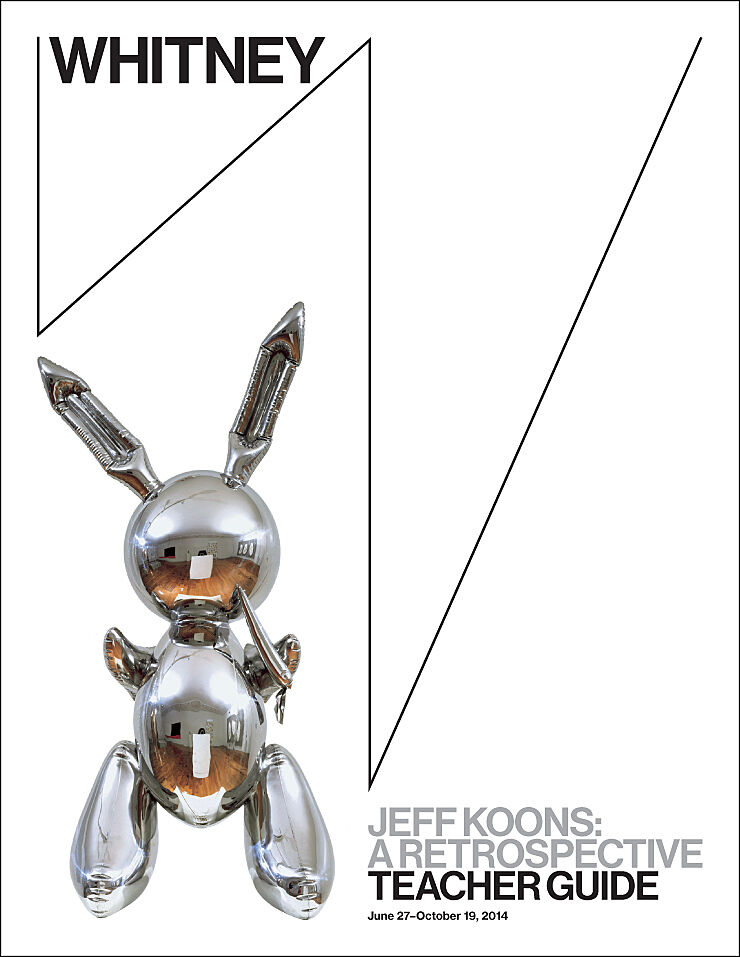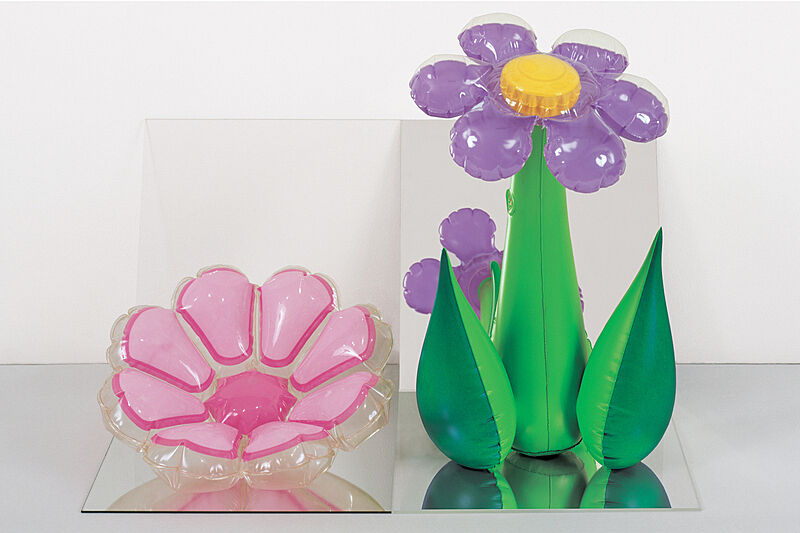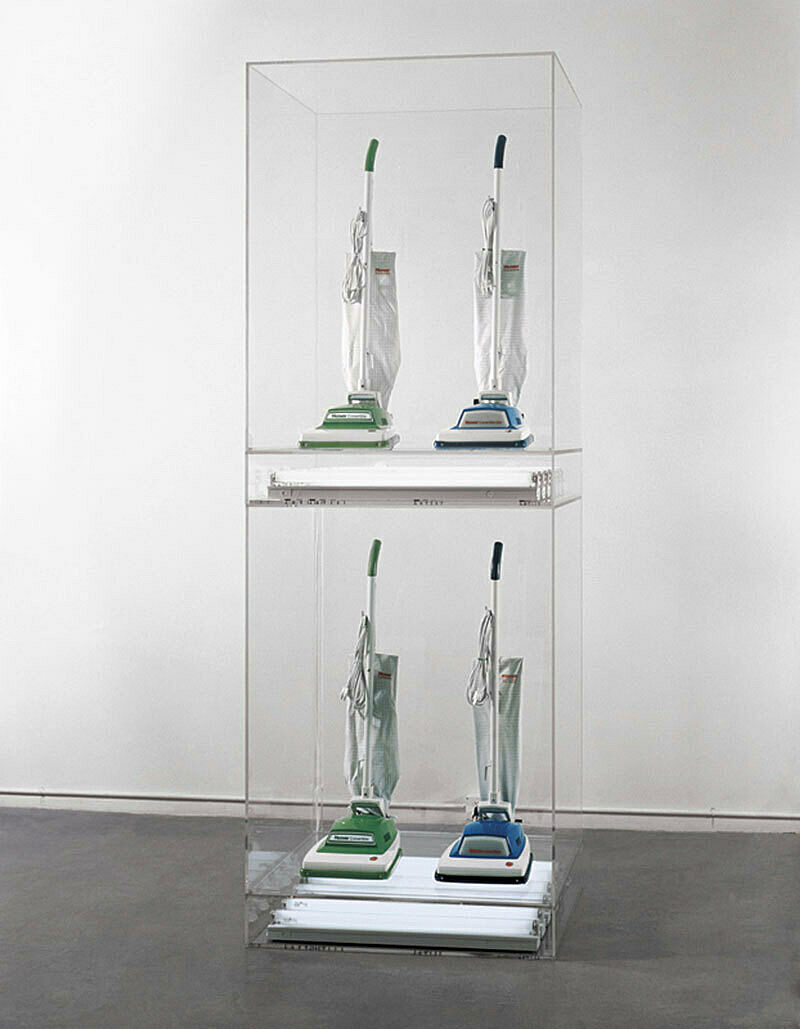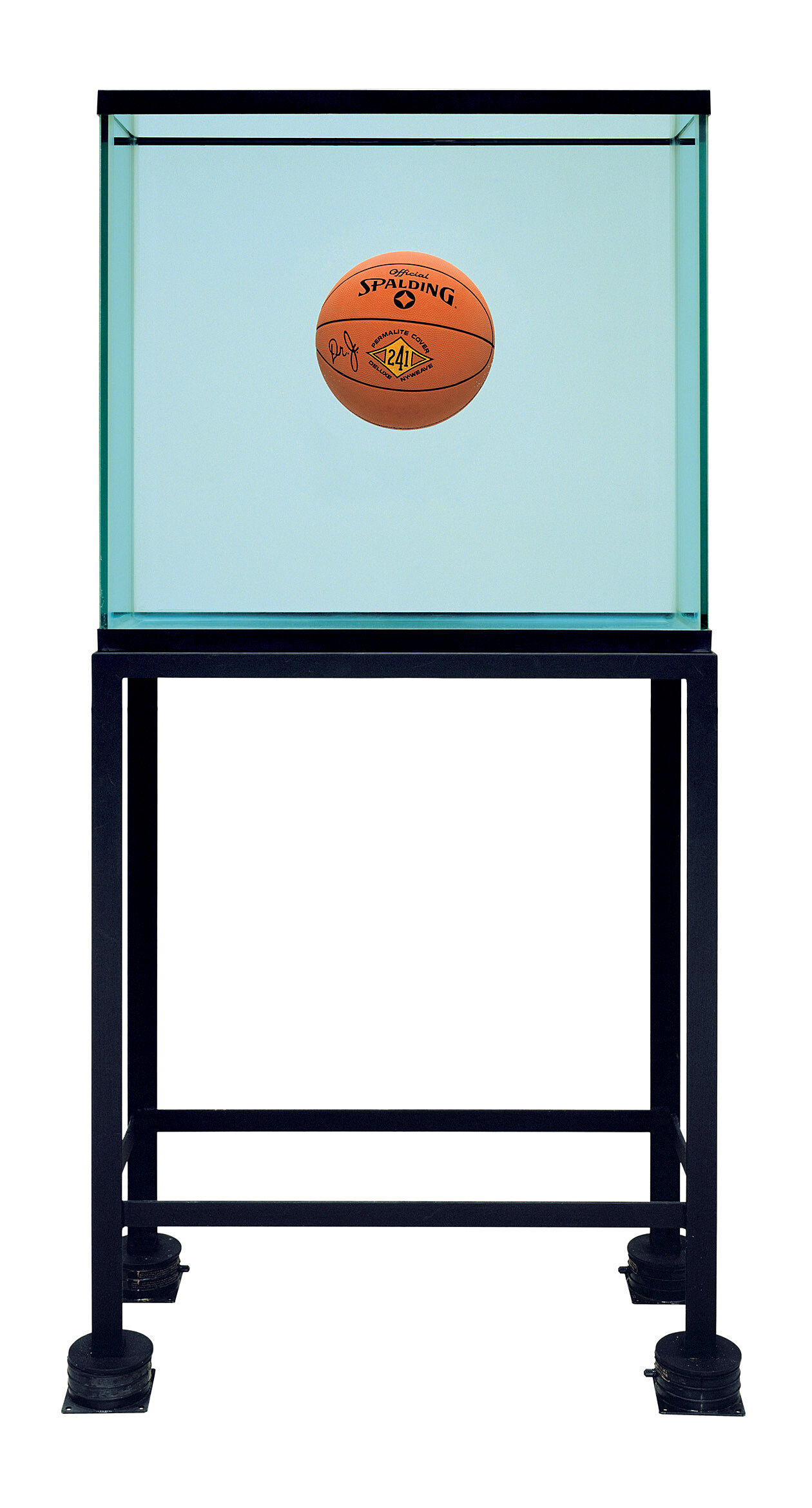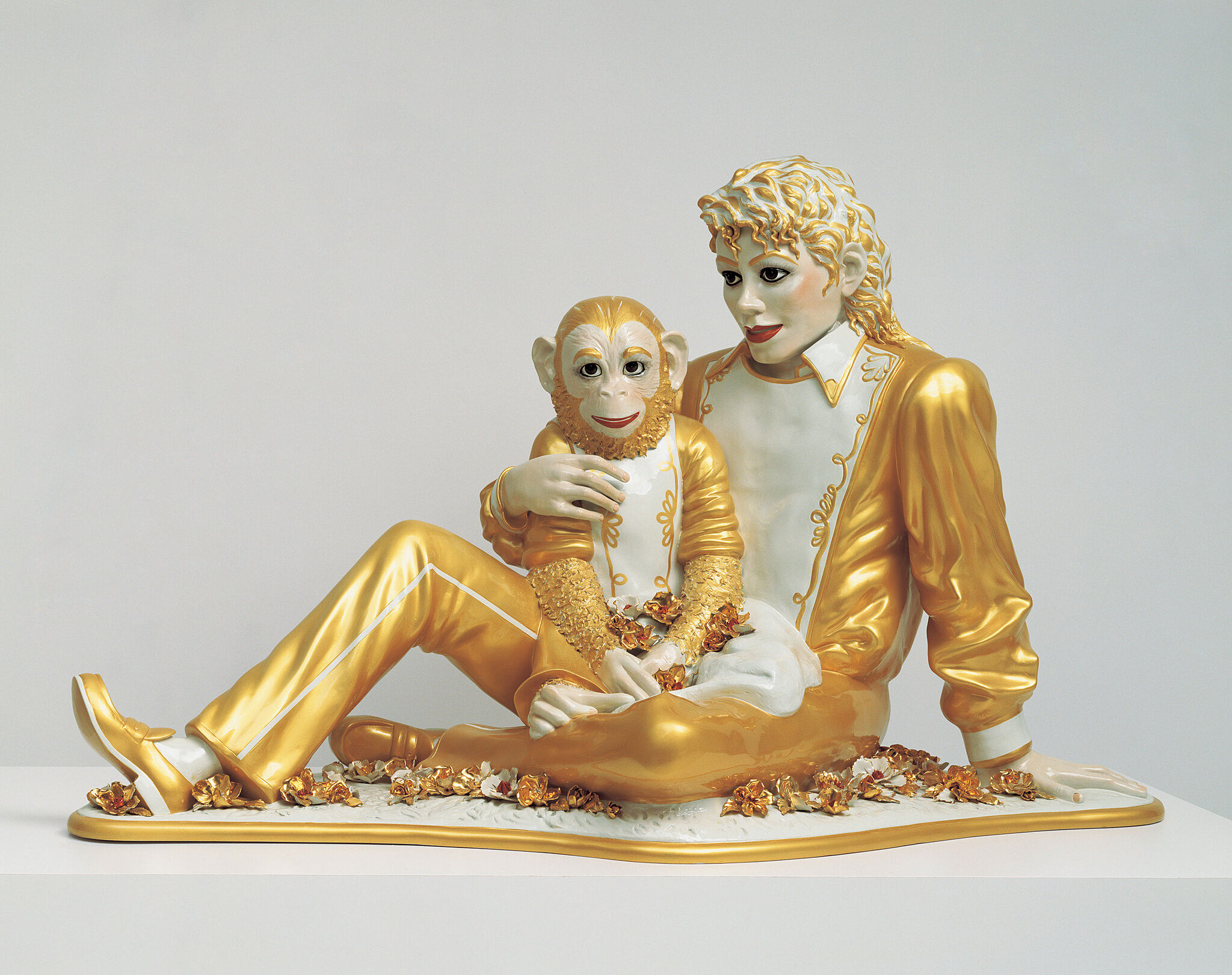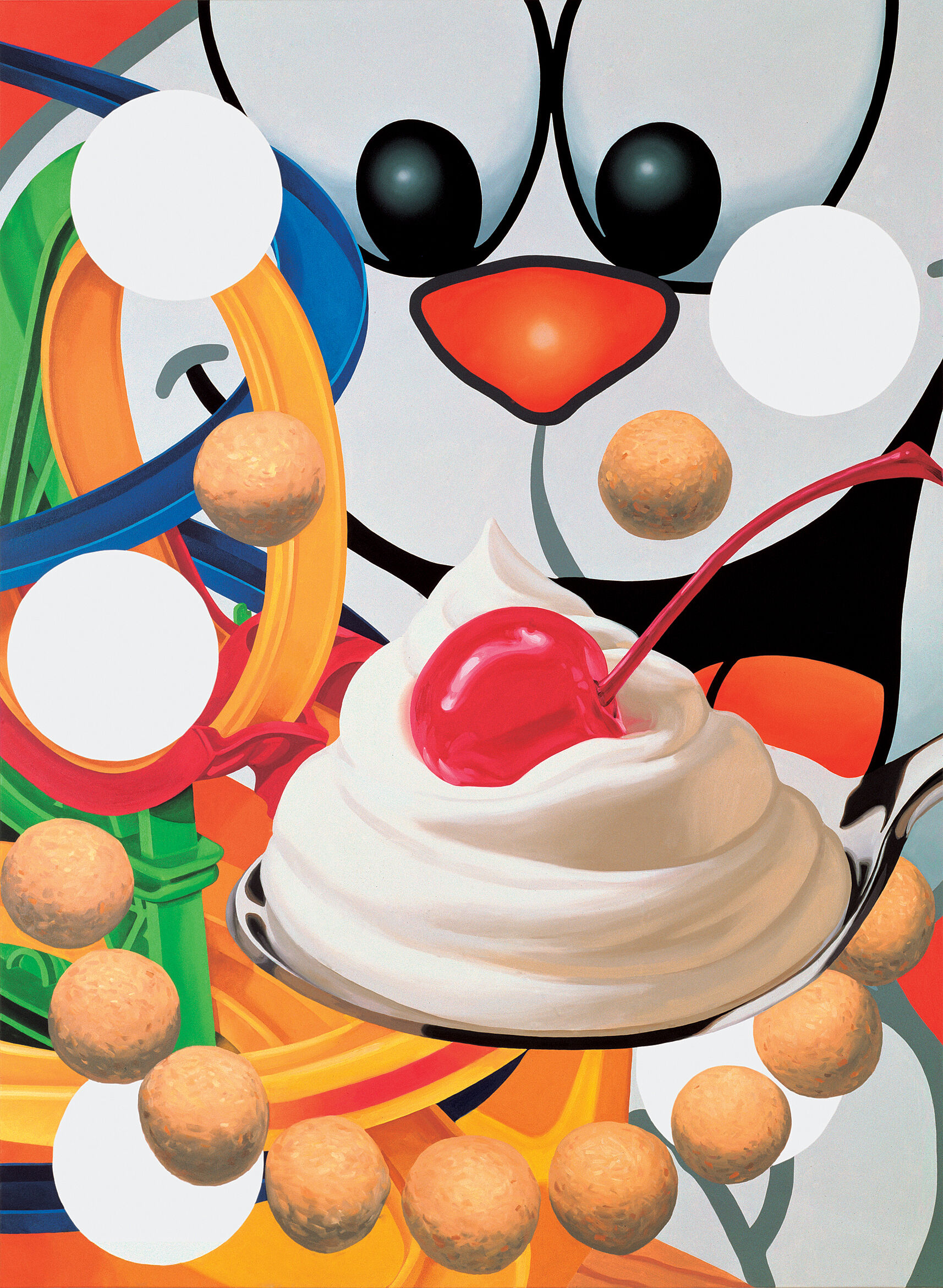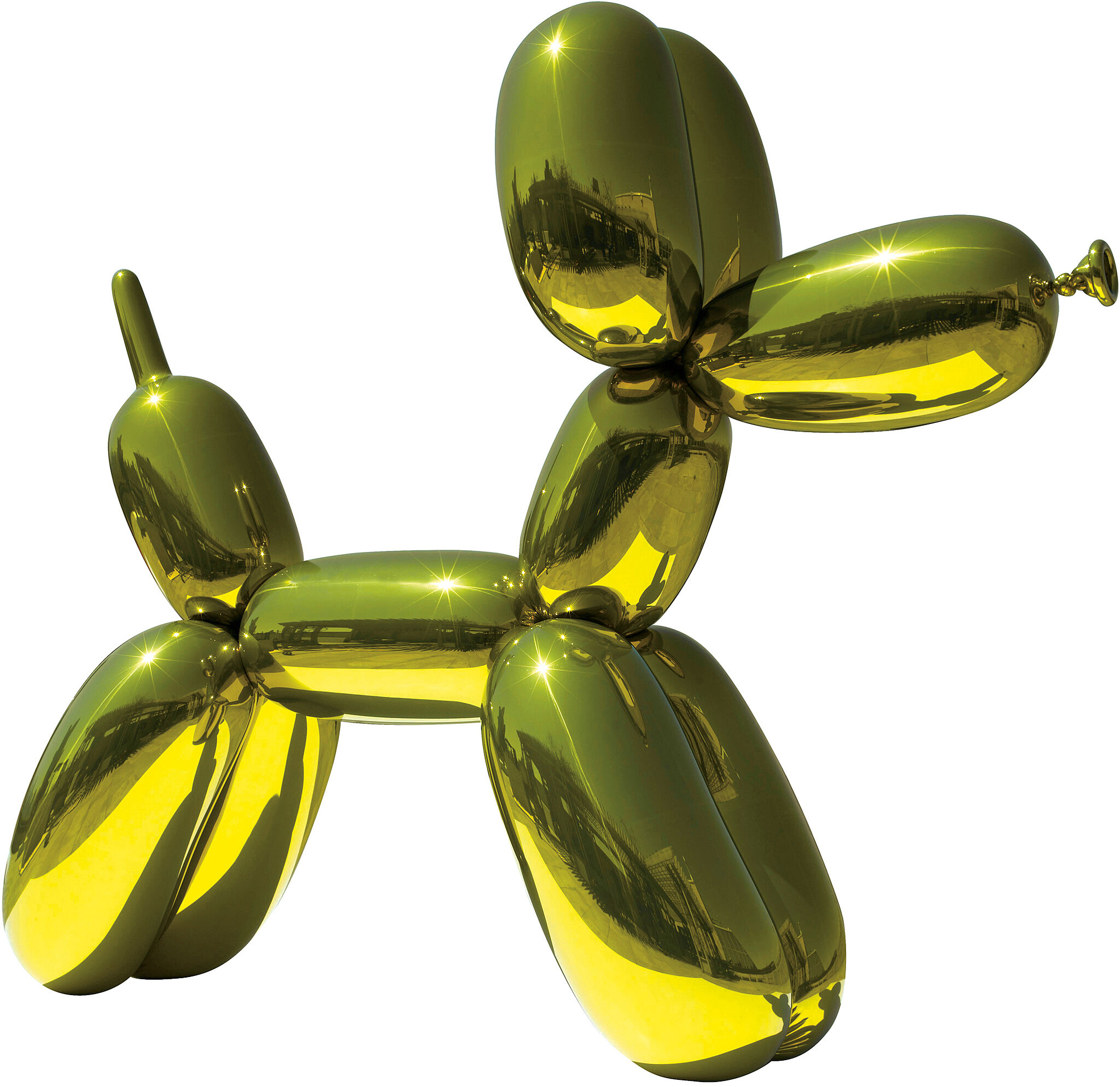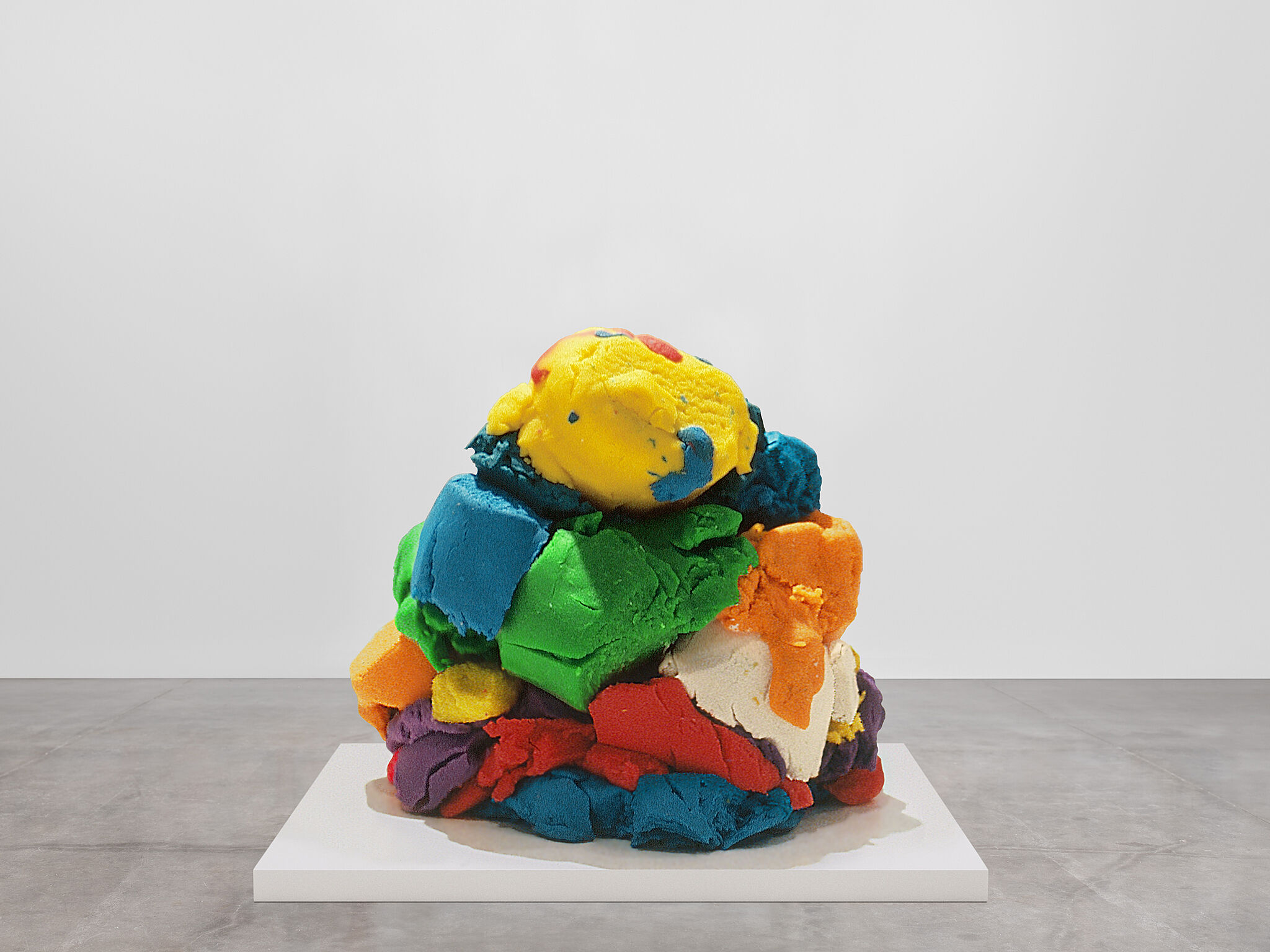Teacher Guide:
Jeff Koons: A Retrospective
Jun 27, 2014
About the Guide
1. How can these materials be used?
These materials provide a framework for preparing you and your students for a visit to the exhibition and offer suggestions for follow up classroom reflection and lessons. The discussions and activities introduce some of the exhibition’s key themes and concepts.
2. Which grade levels are these materials intended for?
These lessons and activities have been written for Elementary, Middle, or High School students. We encourage you to adapt and build upon them in order to meet your teaching objectives and students’ needs.
3. Learning standards
The projects and activities in these curriculum materials address national and state learning standards for the arts, English language arts, social studies, and technology.
4. Feedback
Please let us know what you think of these materials. How did you use them? What worked or didn’t work? Email us at schoolprograms@whitney.org.
About this Exhibition
Over the past thirty-five years, Jeff Koons has become one of the most popular, influential, controversial, and important artists of the postwar generation. Throughout his career, he has pioneered new approaches to the readymade, tested the boundaries between advanced art and mass culture, and challenged the limits of industrial fabrication in works of great beauty and emotional intensity. Outside of his studio, Koons has transformed the relationship of artists to the cult of celebrity and the global market to become one of the best-known visual artists alive today.
Jeff Koons: A Retrospective is the artist’s first large-scale museum presentation in New York and also the first time that a single artist’s work will fill nearly the entire Museum. Organized by Nancy and Steve Crown Family Curator and Associate Director of Programs Scott Rothkopf, the exhibition surveys more than three decades of Jeff Koons’s art and includes approximately 140 works across a variety of mediums. On view from June 27 through October 19, 2014, this landmark exhibition is the Whitney’s grand finale in its uptown Breuer building before the Museum opens its new building downtown in spring 2015.
Jeff Koons: A Retrospective features a range of works from each stage of the artist’s career, representing the following series: Inflatables, Pre-New, The New, Equilibrium, Luxury & Degradation, Statuary, Banality, Made in Heaven, Easyfun, Celebration, Popeye, Hulk Elvis, Antiquity, and Gazing Ball. In addition, the Whitney is showing several new pieces by Koons, including the monumental Play-Doh, which the artist has been working on for more than twenty years. Rothkopf remarks: “It’s hard to think of another living artist who has pushed as many aesthetic and cultural limits as Koons has.”
Pre-Visit Activities
Before visiting the Whitney, we recommend that you and your students explore and discuss some of the ideas and themes in the Jeff Koons: A Retrospective exhibition. You may want to introduce students to at least one work of art that they will see at the Museum. See the Images and Related Information section of this guide for examples of works that may have particular relevance to the classroom.
Objectives:
- Introduce students to the work of Jeff Koons.
- Make connections with some of the artist’s sources of inspiration.
- Introduce students to the themes they may encounter on their museum visit such as “Artist as Observer” and “Artist as Experimenter.”
Since the early 1980s, Jeff Koons has used common objects to comment on the commercialism that characterizes our contemporary world. From his early works to his recent sculpture and paintings, Koons has built on the idea of Marcel Duchamp’s readymade sculptures: he has elevated familiar objects—inflatable toys, basketballs, vacuum cleaners—from the mundane to the exceptional, providing a powerful commentary on the culture in which we live and art’s place within that culture.
Artist as Experimenter
Readymades
In 1913, French artist Marcel Duchamp invented the readymade by taking an ordinary object such as a stool, a bicycle wheel, a shovel, and a urinal, often modifying the object slightly, and displaying that object as art. This provocative act challenged the importance of aesthetics and questioned what art could be. Since the early twentieth century, the readymade has had a profound impact on the ideas and work of many artists, including Koons. Indeed, Koons has not only displayed unaltered objects as his own, he has also made meticulous replicas of mundane objects, pushing the concept of the readymade to new limits. Koons began experimenting with the idea of the readymade when he moved to New York in the late 1970s. He purchased inflatable plastic toys from discount stores on Manhattan’s Fourteenth Street, Broadway, and Lower East Side. Back in his apartment, he would make sculptures by arranging the toys against mirrored and transparent plexiglass tiles. These works were some of Koons’s first readymades.
Show your students Inflatable Flowers (Short Pink, Tall Purple), 1979. What materials do students expect to be used in a work of art? What makes something art? Use the information above and the resources section to discuss what a readymade is. How do ordinary objects provide a reflection of or commentary on the society we live in?
a. Ask your students to choose a consumer object that they would want to turn into a work of art.Why did they choose this particular object? Why should it be art? Who gets to decide if an object is art or not?
b. Have students look closely at the object, noting all of its details. How would they describe this object to someone who has never seen it before? What is the most significant thing about this object? Explore the materials it is made of and what the object is used for. Has this type of object changed over the years? In what ways? What does this object suggest about our society and the time in which it was made?
Artist as Observer
Almost Human
To Koons, the inflatables possessed human-like qualities. He said: “I think of the inflatables as anthropomorphic, we are ourselves inflatables, we take a breath, we expand, we contract, our last breath in life, our deflation.”
With your students, review Inflatable Flowers (Short Pink, Tall Purple), 1979. Think about how an inflatable works. What might happen to these objects in their lifecycle? How might they change over time?
a. Ask students to unpack and discuss the word anthropomorphic and its meaning. For example, anthro is related to anthropology, the study of humans and morph is when something transforms into something else. Ask students to research and discuss dictionary definitions of anthropomorphic. In what ways do Koons’s inflatables remind your students of humans? Use their dictionary findings and definitions of anthropomorphic as a jumping-off point to explore Koons’s works and debate whether they have anthropomorphic qualities or not.
b. Koons has also referred to works such as New Hoover Convertibles, Green, Blue; New Hoover Convertibles, Green, Blue; Double-Decker (1981–87) as both family units and as “. . . breathing machines. Many aspects of them are anthropomorphic that relate to an individual.”
With your students, view and discuss this sculpture. Ask students to think about how vacuum cleaners work. In what ways might they be anthropomorphic?
c. What other everyday objects have anthropomorphic qualities? Ask students to look for anthropomorphic objects around their classroom or home. Discuss what makes these objects anthropomorphic—is it their shape, function, or both?
d. Ask students to find works of art in the Whitney’s online collection that have anthropomorphic qualities /collection/works. Have students work in small groups to identify a work and share with the class how this work is anthropomorphic.
Koons’s 1985 exhibition Equilibrium in the East Village featured posters and sculptures on the subject of basketball—an icon of contemporary popular culture whose stars Koons saw as “sirens” beckoning young people (especially African Americans) with the promise of social mobility through sports and shoes.
Ask your students to explore what an icon is. They could research its meaning on the internet or in dictionaries. Then view and discuss Koons’s work One Ball Total Equilibrium Tank (Spalding Dr. J 241 Series), 1985. Why do students think Koons chose to display a basketball in this way? Discuss what basketballs and basketball stars might represent in our culture. How might they be seen as contemporary icons?
a. For Michael Jackson and Bubbles, 1988 Koons transformed a famous photograph of the late pop star Michael Jackson and his pet chimpanzee, Bubbles into a sculpture. This work, part of a series of sculptures that Koons titled Banality, was intended to speak to a broad audience by using familiar figures like Michael Jackson, Buster Keaton, and the Pink Panther. Koons used the same triangular configuration in his composition as Michelangelo’s Pietà, suggesting the almost religious fervor that contemporary pop stars inspire, but also the sacrifces that they make to be idolized by their fans.
b. Ask students to view and discuss Michael Jackson and Bubbles, 1988 and compare Koons’s sculpture with Michelangelo’s Pietà (1498–99).
http://www.italianrenaissance.org/michelangelos-pieta/
What statement do students think Koons is making by elevating Michael Jackson to the status of a religious figure?
c. Michael Jackson could also be seen as the most idolized pop star of his time, representing an icon of adoration and sacrifice. Ask students to identify and discuss other current icons or icons in art history. In what ways do they represent historical or contemporary culture in which they were made?
d. When Michael Jackson and Bubbles was made in 1988, Jackson was arguably the most famous entertainer in the world, and Koons admired him, just as the artist’s own celebrity was reaching new heights. “If I could be one other living person,” Koons remarked at the time, “it would probably be Michael Jackson.” If each of your students could be one other living person, who would they choose to be? Why?
In New Hoover Convertibles, Green, Blue; New Hoover Convertibles, Green, Blue; Double-Decker (1981–87), Koons displays actual vacuum cleaners stacked on two levels in a plexiglass vitrine, as if they were for sale on a showroom floor. The plexiglass case is also similar to a vitrine that displays precious objects in a museum. For Koons, these readymade vacuum cleaners recall the shiny, new Hoover vacuums that door-to-door salesmen would sell to his mother during the 1950s. Koons also refers to childhood memories of in his father’s home décor store, Henry J. Koons Interiors, where brand new household objects were displayed to entice consumers and tempt their aspirations for newness, status, and perfection.
With your students, view and discuss Koons’s sculpture, New Hoover Convertibles, Green, Blue; New Hoover Convertibles, Green, Blue; Double-Decker, 1981–87. Koons did not make these vacuum cleaners but he chose how to display them. He sealed the pristine vacuum cleaners in the case and has said that if they were ever used, the sculpture would be destroyed. Why do students think that Koons chose to display the vacuum cleaners in the vitrine? How is Koons making us look at the vacuum cleaners in a new way?
a. Which contemporary consumer products are your students excited about? Which products represent a state of perfection or status to them? Can they imagine looking back at these objects ten or twenty years from now?
b. If your students chose a set of brand new contemporary products to display, what would they choose? Why? How many would they choose to display? What color(s) would they be? How would they arrange these objects?
c. Koons was inspired by the displays of furniture and household objects in the showroom of his father’s home décor store in the 1950s. A contemporary example would be the displays of home products and appliances at Ikea stores. Ask your students to explore store windows, product websites, or TV advertisements for inspiration for their reimagined display. Have them use web or magazine images to make a presentation of their chosen products. View and discuss students’ presentations. What products did they choose? Why?
Post-visit Activities
Objectives
- Enable students to reflect upon and discuss some of the ideas and themes from the exhibition.
- Have students further explore some of the artist’s’ approaches through discussion, writing, and art-making activities.
Artist as Observer
Thematic Collage
For Loopy, 1999 and other paintings from the Easyfun series, Koons began each composition with readymade images culled from product packaging, advertisements, and magazine photography. He then made paper studies that he scanned and manipulated further using Photoshop software. To execute each canvas, Koons worked with teams of assistants for up to six months, painstakingly applying thousands of computer-calibrated colors by hand.
Loopy is a large scale painting at 9 feet tall. Circles and curves are prominent shapes in the painting. With your students look closely at this work. What do they notice about the composition? What connections can students find between the lines, shapes, and colors in this painting? Do students recognize any of the images in the painting? What other connections can they make with the images?
a. Ask your students to pick a topic of their choice, such as food, household products, toys, or digital devices. Have them find images that relate to their topic and create a collage composition. For collage material, students could use product boxes, wrappers, labels, and magazine images. Ask students to try and make all of the parts of their composition relate and connect by using line, shape, and color.
b. If older students have access to computers and imaging software such as Photoshop, ask them to scan their collages and use the software tools to further manipulate the lines, shapes, and colors of their collages.
c. Display students’ analogue and digital collages in your classroom. What did they choose as their theme and why? What connections did they make within their compositions? Are their themes and collage images related to their own lives? In what ways?
Artist as Experimenter
Reimagine an Everyday Object
Balloon Dog (Yellow), 1994-2001 is ten feet high and weighs a ton. Koons worked with a foundry in California to cast and finish the work’s sixty separate precision-engineered, stainless steel parts. Play-Doh is also ten feet high and made of twenty-seven pieces of painted aluminum, exactly replicating a mound of Play-Doh that his son made. On first glance, both works look deceptively simple, but they represent some of the most complex sculptures Koons has ever made. Koons carefully considered the texture, cracks, and surface detail of his son’s Play-Doh artwork and the intricate, sublte curves and puckers of a real balloon dog. He had both sculptures cast in particular ways to retain the integrity and perfection of the objects themselves, and they took years and specialized technical expertise to fabricate.
With your students, discuss Play-Doh, 1994-2014 and Balloon Dog (Yellow), 1994-2001. Ask students to describe what they noticed about these works during their museum visit. How did Koons capture the spirit of these objects? What does it mean for an artist to spend so many years making something?
a. Ask students to work in small groups and make a proposal for a sculpture of an ordinary object. Have students challenge themselves to recreate the object as an exact replica of the original, but on a much larger scale. Ask student groups to write their proposal and make sketches of their sculpture. Include a figure for scale.
Ask students to consider:
— What materials they would use.
— What texture the object would have.
— What its scale would be.
— How many parts the object would have.
— How the finished object will look.
— How they would make the object. Describe the process.
— What technique would they use? Casting, carving, modeling, or assembling?
— Would they make the object themselves or have it fabricated by a craftsperson or manufacturer?
— Where they would put it and why?
b. View and discuss student proposals. What object did they propose to recreate? How did they decide which materials to use? How did they propose to make the object?
Images and Related Information
Jeff Koons
Inflatable Flowers (Short Pink, Tall Purple), 1979
While searching for commercial products to incorporate into his art, Koons tirelessly perused the bins of the discount shops that extended across Fourteenth Street, Broadway, and New York’s Lower East Side. In so doing, he developed a connoisseur’s eye for the pleasures to be found in cheap toys and tchotchkes. Perhaps the most enduring of the products he encountered at this time were inflatable vinyl toys. Apart from their tactile surfaces and bright colors, Koons found a deeper message running through these objects—one that spoke to nothing less than mortality. He has said, “I think of the inflatables as anthropomorphic, we are ourselves inflatables, we take a breath, we expand, we contract, our last breath in life, our deflation.”* With these words in mind, the optimism of his chosen products are also haunted by the specter of death.
*Jeff Koons quoted in Stephanie Murq, “Jeff Koons: We Are Ourselves Inflatables,” August 6, 2009.
Jeff Koons, New Hoover Convertibles Green, Blue, New Hoover Convertibles, Green, Blue Doubledecker, 1981–87. Four vacuum cleaners, acrylic, and fluorescent lights; 116 × 41 × 28 in. (294.6 × 104.1 × 71.1 cm). Whitney Museum of American Art, purchase with funds from The Sondra and Charles Gilman, Jr. Foundation, Inc., and the Painting and Sculpture Committee 89.30a-v. ©Jeff Koons
Jeff Koons New Hoover
Convertibles Green, Blue, New Hoover Convertibles, Green, Blue Doubledecker, 1981–87
In 1980 Koons unveiled the earliest works from his series The New in his first exhibition, held in the New Museum’s storefront window on Fourteenth Street. The display featured three illuminated reliefs affixed with vacuum cleaners, as well as lighted sign announcing the title of the series and the show. With these works and the freestanding encased examples that followed, Koons sought to capture the very essence of newness. None of the vacuum cleaners in any of these works has ever been used, and the artist has claimed that doing so would destroy the sculptures. The appliances are presented as pristine objects of desire, a quality exaggerated by their otherworldly glow. Yet, almost paradoxically, the specimens in these antiseptic chambers have inevitably grown dated, suggesting that the eternal and inexorable quest for the “new and improved” in both art and commerce is inherently shadowed by the threat of obsolescence.
Growing up in suburban Pennsylvania in the 1950s, Koons remembers the experience of Hoover vacuum cleaner salesmen coming to tempt his mother with the newest models on the market. Koons himself would knock on doors as a child to sell gift-wrapping paper and candies to neighbors. “I enjoyed the experience,” he recalls of his earliest salesmanship, which he described as a way of “meeting people’s needs.” In works such as this sculpture, Koons reflects on the powerful promise of products to enhance our lives. Distinguished by small details such as color, each is designed to capture our attention. In these works, Koons also plays with conventions of display, which he learned firsthand in his father’s home decorating shop. Artworks, like consumer goods, depend on lighting and cases to frame them and heighten their allure. By presenting the vacuums in these monolithic enclosures, Koons recaptures the fervent, almost religious excitement that the newest lines of products—and artworks—can inspire in us.
Jeff Koons
One Ball Total Equilibrium Tank (Spalding Dr. J 241 Series), 1985
Koons staged his first solo gallery exhibition in 1985 at International with Monument, a center of activity amid the flourishing Lower East Side art scene. Entitled Equilibrium, the show presented a multilayered allegory of, in Koons’s words, unattainable “states of being” or salvation. The exhibition’s best-known works remain the tanks in which basketballs miraculously hover. These sculptures expand philosophically on The New: while that series addressed the perfect moment of creation, Koons described Equilibrium as a moment of pure potential: “Equilibrium is before birth, it’s in the womb, it’s about what is prior to life and after death. It’s this ultimate state of the eternal that is reflected in this moment.”
The stillness of this gravity-defying basketball continues to surprise viewers nearly thirty years after its debut. In consultation with the Nobel Prize–winning physicist Richard P. Feynman, Koons realized that by first filling more than half the tank with a solution of highly refined salt and distilled water and then filling the ball itself with distilled water, the ball would float on the heavier substance; he then poured more distilled water into the top portion of the tank. This precise equilibrium, however, does not last forever. Temperature fluctuations and vibrations from viewers’ footsteps blend the solutions of water, ultimately causing the ball to sink. For Koons, the inevitability of this failure provides the work’s theme of perfect balance with a poignant counterpoint of instability.
Jeff Koons
Michael Jackson and Bubbles, 1988
Unlike Koons’s earlier sculptures based on readymade sources, those in this series—Banality—ventured into the realm of kitsch. They include mash-ups of stuffed animals, gaudy figurines, and images taken from magazines, packaging, films, and even Leonard Da Vinci. Nothing was too corny, too cloying, or too cute. Working with traditional German and Italian craftsmen, Koons enlarged his subjects and rendered them in gilt porcelain and polychrome wood, materials more associated with decorative housewares and tchotchkes than contemporary art. As with his previous series, he conceived of Banality as an elaborate allegory, this one aimed at freeing us to embrace without embarrassment our childhood affection for toys or the trinkets lining our grandparents’ shelves.
Rendered larger than life in gilded porcelain, this sculpture is based on a publicity photograph of the late pop superstar Michael Jackson and his beloved pet chimpanzee, Bubbles. When the work was made, Jackson was arguably the most famous entertainer in the world, and Koons admired him as the epitome of mainstream appeal, just as the artist’s own celebrity was reaching new heights. “If I could be one other living person,” Koons remarked at the time, “it would probably be Michael Jackson.” Koons praised Jackson as someone willing to do “absolutely anything that was necessary to be able to communicate with people.”
In Koons’s eyes this included plastic surgery and skin-lightening procedures that he claimed Jackson undertook to reach more middle-class white audiences. “That’s radicality. That’s abstraction,” Koons said. With his ivory skin tone and rosy cheeks, the sculpted Jackson hints at this transformation as well as at the fraught entanglement of celebrity, money, and race in the United States. The work’s composition is indebted to Michelangelo’s Pietà (1498–99), in which Christ lies on the lap of Mary after his crucifixion, an association that suggests the extent to which Pop stars sacrifice themselves for fans who shower them with an almost religious adoration.
Jeff Koons
Loopy, 1999
Although Koons had explored different forms of painting since the early 1980s, his series entitled Easyfun (1999-2000) and Easyfun-Ethereal (2000-2003) signal the start of his engagement with handmade oils on canvas, which has continued until today. He began each composition with readymade images culled from product packaging, advertisements, and magazine photography, then imaginatively grafted these fragments within paper studies that he scanned and manipulated further using Photoshop software. To execute each canvas, Koons worked with teams of assistants for up to six months, painstakingly applying thousands of colors calibrated across the surfaces with the aid of computers but mixed and painted entirely by hand.
Inspired in part by Picasso’s remark, “When I was a child I could draw like Raphael, but it took me a lifetime to draw like a child,” Loopy and other paintings from the Easyfun series aim to recapture the innocent spirit of childhood. The smiling cartoon rabbit at the top of the canvas is the familiar mascot of Trix cereal. Its red nose is echoed in the cherry crowning a dollop of whipped cream, while its smile is doubled in the crescent of cereal pieces curving across the bottom of the picture. Winding through this imagery are tracks made for Hot Wheels toy cars and white polka dots that Koons has linked to the work of artist John Baldessari. Koons has commented that he hopes his paintings capture our attention and inspire emotions as strongly as the simple cereal box that grips a child’s imagination each day at breakfast.
Jeff Koons
Balloon Dog (Yellow), 1994–2000
Koons conceived his series Celebration in 1994 as a paean to the milestones that mark a year and the cycle of life. Fittingly, it was inspired by an invitation to design a calendar for which he created photographs that referred to holidays and other joyous events. These images formed the basis for a series of large-scale sculptures and paintings.
Despite its ten-foot stature and one-ton weight, Koons’s Balloon Dog (Yellow) uncannily conveys its ephemeral source. Koons worked with a specialized foundry in California to cast and finish the work’s separate precision-engineered, stainless steel parts. He stipulated that not only should the outside of the sculpture capture the curves and puckers of a balloon dog but also that its inside suggest the free circulation of air, as if it were actually fashioned from a single balloon. Koons has also compared its form to a “Trojan horse,” the giant wooden gift that the Greeks bestowed on their Trojan enemies, while Greek soldiers lurked inside to surprise their enemy. Like all of the Celebration sculptures, Balloon Dog (Yellow) is one of five examples in different colors, lending each version a unique character and distinct emotional charge.
Jeff Koons
Play-doh, 1994–2014
In contrast to the perfect smoothness and largely monochromatic palette of many works in Koons’s Celebration series, this sculpture represents an enormous craggy mound of Play-Doh. The material is one of the first that American children use to make simple artworks, and Koons remembers his son Ludwig proudly presenting him with a Play-Doh sculpture. Yet here the freedom, confidence, and spontaneity of the boy’s initial gesture ironically prompted one of the most complex sculptures Koons has ever made, requiring two decades to fabricate. The sculpture was first conceived in polyethylene but was ultimately fashioned from twenty-seven individual interlocking pieces of painted aluminum, unveiled for the first time in this retrospective exhibition. The mountain of Play-Doh may call to mind scatological associations or geological forms, but for Koons, it’s also “a very joyous, very pop material.” A perfect replica of an offhand creation, Play-Doh serves as a monument to childlike imagination.
About the Artist
Jeff Koons B. 1955
Born in York, Pennsylvania, Jeff Koons studied at the Maryland Institute of College of Art (MICA) in Baltimore, earning his BFA in 1974, and studied at the School of the Art Institute of Chicago (1975-76). While he was attending the Art Institute, Koons worked as studio assistant for painter Ed Paschke who encouraged Koons’s interest in pop culture. After moving to New York City in 1977, Koons worked at the Museum of Modern Art and on Wall Street for several years before his career as an artist took off. In the early 1980s, he boldly emerged with his first series of works, entitled The New, which consisted primarily of new household appliances displayed in plexiglass cases. Soon after, he adopted the role of a prototypical American art star, actively cultivating his own image and running splashy advertisements in art magazines featuring pictures of himself that appeared to flaunt the lifestyle afforded by his artistic success.
In subsequent work, Koons has explored a range of commercial objects, including basketballs suspended in aquariums of distilled water and monumental paintings and sculptures of pop culture objects. Much of his subject matter is drawn not from high-end products, but from kitsch—inflatable toys and cheap ceramic figurines. Koons employs assistants and fabricators to copy these objects with the highest attention to detail and often in fine materials such as porcelain, crystal, and stainless steel. “I’m basically the idea person. I’m not physically involved in the production,” he explained in a 1986 interview. “I don’t have the necessary abilities, so I go to the top people, whether I’m working with my foundry or in physics.” Despite the suspicions of critics, Koons has denied accusations of insincerity and cynicism in his work. He once said, “I do believe that art is a hub that connects all of the disciplines of the world. Art can do that because it is so open and so easily clarifies things. It connects theology with philosophy and psychology and aesthetics and physics and any other discipline.”
Koons is one of the few artists of his generation who has transcended the fine art world to work with a variety of cultural figures, including filmmaker Gus Van Sant, fashion designer Stella McCartney, and pop star Lady Gaga, in addition to having designed a BMW Art Car in 2010. Koons has also partnered with several companies such as Kiehl’s and Dom Pérignon for special editions of products, often with proceeds going to charity. He founded the Koons Family Institute, an initiative of the International Center for Missing and Exploited Children. Among his many honors, Koons was named an Officier de la Legion d’Honneur by the French government in 2010, an Honorary Member of the Royal Academy of the Arts in London in 2010, and Hillary Clinton presented him with the U.S. State Department’s Medal of Arts in 2012. His work is in the collections of many prestigious institutions in the United States and around the world.
Klaus Ottman, Interview with Jeff Koons, Journal of Contemporary Art, New York City, October 1986.
Robert Ayers, “Jeff Koons,” April 25, 2008.
Bibliography and links
Scott Rothkopf et al. Jeff Koons: A Retrospective. Whitney Museum of American Art, New York: distributed by Yale University Press, 2014.
Hans Werner Holzwarth, Editor. Jeff Koons. Hong Kong, Köln, London, Los Angeles, Madrid, Paris, Tokyo: Taschen, 2009.
Francesco Bonami, Editor. Jeff Koons. Chicago: Museum of Contemporary Art, Chicago; New Haven: in association with Yale University Press, 2008.
http://www.jeffkoons.com/
Jeff Koons’s website.
http://www.pbs.org/art21/artists/jeff-koons
Jeff Koons on Art21.
https://gagosian.comartists/jeff-koons
Jeff Koons on Gagosian’s website.
/exhibitions/jeff-koons
Jeff Koons exhibition page on whitney.org.
/guides/14
Audio guide for Jeff Koons: A Retrospective.
http://www.moma.org/collection/theme.php?theme_id=10468
A definition of readymade in the Museum of Modern Art’s Art Terms glossary.
/education
The Whitney’s programs for teachers, teens, children, and families.
/for-teachers
The Whitney’s collection and resources for K-12 teachers.
/education/families
A special area of the Whitney’s website with resources and activities for artists ages 8-12.
Credits
This Teacher Guide was prepared by Dina Helal, Manager of Education Resources; Lisa Libicki, Whitney Educator; Heather Maxson, Manager of School, Youth, and Family Programs, and Pauline Noyes, Coordinator of School and Educator Programs.
Free Guided Student Visits for New York City Public and Charter Schools endowed by the Allen and Kelli Questrom Foundation.
Leadership support for this exhibition is provided by

The exhibition is sponsored by



Significant support is provided by Neil G. Bluhm; Steven A. and Alexandra M. Cohen Foundation, Inc.; Susan and John Hess; Cari and Michael J. Sacks; and the National Committee of the Whitney Museum of American Art.
Major support is provided by Anne Cox Chambers, Nancy C. and A. Steven Crown, Stefan Edlis and Gael Neeson, Lise and Michael Evans, Anne Dias Griffin and Kenneth Griffin, Dakis Joannou, Allison and Warren Kanders, Amy and John Phelan, Brett and Daniel Sundheim, and David Zwirner Gallery.
Generous support is provided by The Broad Art Foundation; Melva Bucksbaum and Raymond Learsy; Wendy Fisher; Mr. and Mrs. J. Tomilson Hill; Antonio Homem, Sonnabend Gallery; Miyoung Lee and Neil Simpkins; Liz and Eric Lefkofsky; Linda and Harry Macklowe; the Mugrabi Collection; Brooke and Daniel Neidich; Almine Rech Gallery; David Teiger; and Fern and Lenard Tessler.
Opening Dinner sponsored by


